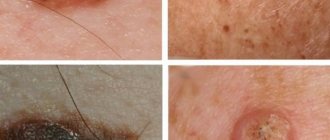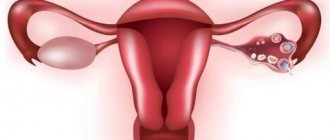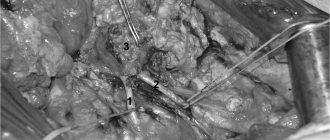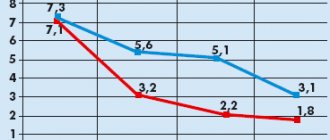Causes of multifollicular ovaries
The work of the ovaries is regulated by hormones from the hypothalamus, pituitary gland and adrenal glands. Under their influence, the glands change cyclically and themselves produce biologically active substances. These processes are aimed at implementing the reproductive function.
At the beginning of the cycle, under the influence of follicle-stimulating hormone, up to 7 follicles mature in each of the gonads, 1-2 of them become dominant and ovulate, the rest regress.
During an ultrasound examination, more than 10 follicles are identified in the structure of a multifollicular ovary. Sometimes this can be a transient state of the norm. Sometimes it can indicate various deviations. This may be due to the following situations:
- irregular cycle in adolescence;
- hormonal changes after abortion, childbirth or during lactation;
- long-term use of oral contraceptives;
- stress;
- climate change;
- excessive loads;
- taking certain medications;
- sudden change in body weight, etc.
Structural changes in the ovaries can be caused by the following conditions:
- endocrine diseases;
- genetic mutations;
- metabolic disorders.
During an ultrasound examination, it is important for the sonologist to differentiate multifollicular ovaries from true polycystic disease by the structure of the gonads. With polycystic disease, the ovaries are larger in size, and the follicles, the number of which is greater than normal, range in size from 5 to 7 mm (small follicular ovaries).
Multifollicularity and polycystic disease
Polycystic disease can be a consequence of multifollicularity, but is in no way synonymous with it, and, secondly, it has nothing to do with cysts. According to many studies, approximately every third or fourth ultrasound reveals multifollicular ovaries - hence it is clear that this condition is not rare and somehow very special. While about 3-4% of women are diagnosed with polycystic ovary syndrome.
The difference between these two diagnoses is as follows:
- Echogenicity - determines the density of the tissue of the organ being studied. With MFN, the echogenicity of the ovaries does not exceed the echogenicity of the uterus. With PCOS it is much higher, the ovarian tissue is much denser than the uterine tissue.
- Ovarian size – with MFN, the ovaries are slightly larger than normal in volume. Often the values are at 34 - 37 mm length and 18 - 22 width. With PCOS, the length of the ovary is always more than 40 mm; in this case, an experienced uzologist will determine even before taking measurements that they are greatly enlarged.
- The hormones DEHA and 17-OH progesterone are male hormones produced by the adrenal cortex. With MFN, their values remain within normal limits (it is acceptable even if they are at the upper limit of normal). With PCOS, the levels of these hormones are always elevated.
- Follicle size - both diagnoses involve multiple follicles in the ovaries, but with MFN their diameter does not exceed 9 mm. In PCOS, many of these follicles become large, but none are able to ovulate.
- Thickness of the follicle capsule – with PCOS, the follicle capsule is always very thick. Therefore, even if an egg matures in it, it does not have the opportunity to come out, even if a sufficient amount of the LH hormone is produced in the woman’s body. Thus, a follicular cyst is formed. With MFN, such cysts also occur, but much less frequently (no more than 2 times a year).
- The location of the follicles - on an ultrasound machine it is clearly visible where the follicular apparatus is localized. In MFN, the antral follicles are located diffusely. In PCOS, they are almost always located peripherally, in the shape of a necklace.
Symptoms of multifollicular ovaries
Temporary disruptions in the functioning of the reproductive organs are often asymptomatic and discovered by chance.
Signs of pathological causes of multifollicular ovaries are the following symptoms:
- sudden weight gain;
- redistribution of adipose tissue according to the male type;
- excess hair on the body and face;
- menstrual irregularities;
- problems with conception;
- decreased libido;
- excess oily skin;
- hair loss;
- change in the nature of menstruation;
- emotional lability;
- irritability.
The combination of the described clinical picture with structural changes in the gonads is an indication for a detailed examination of the female body. A personal advanced diagnostic program will be drawn up by a gynecologist after studying the clinical situation.
Diagnostics
If multiple follicles are detected during an ultrasound of the female genital organs, you should contact a gynecologist. Diagnosis of the causes of multifollicular ovaries begins with a conversation, during which the doctor finds out:
- woman's age;
- obstetric history (pregnancy, childbirth, abortion);
- cycle duration;
- the nature of menstruation;
- features of sexual life;
- presence of complaints.
Analyzing the information received, the doctor determines the likelihood of a pathological origin of the dysfunction and chooses tactics for further management of the patient.
If an ultrasound reveals other structural abnormalities (follicle diameter more than 12 mm, increased gonadal density or thickening of the membrane), and the medical history indicates a possible pathology, the woman is prescribed additional examination. Diagnostics includes laboratory (general blood count, hormone tests, biochemical tests for glucose and lipoprotein levels) and instrumental procedures (ultrasound of the adrenal glands, thyroid gland, folliculometry, MRI of the sella turcica, etc.)
Causes and mechanism of formation of pathology
The causes of the disease are hereditary. Inheritance is indirect, as it is caused not by one gene, but by their combination. Polycystic ovary syndrome, the causes of which are not yet fully understood, is accompanied by:
- decrease in the level of female hormones - estrogens;
- an increase in the amount of the male hormone - testosterone;
- increased concentration of insulin, a pancreatic hormone;
- the ratio of luteinizing and follicle-stimulating hormones is 2.5–3 (with the norm being 1.5–2).
However, experts identify the following reasons:
- increased production of androgens;
- obesity, overweight;
- hormonal imbalances;
- anxiety, prolonged depression;
- hereditary predisposition;
- consequences of infectious inflammatory processes;
- climate impacts;
- intoxication of the body;
- severe brain pathologies;
- complications during pregnancy/childbirth.
Insulin resistance is one of the most common causes of PCOS. Insulin is a pancreatic hormone responsible for blood sugar levels. If insulin sensitivity decreases, androgens (male sex hormones) are synthesized excessively.
Under the influence of androgens, the outer shell of the ovaries begins to thicken, and mature follicles are not able to collapse. Thus, they enlarge and fill with fluid, transforming into cysts.
Obesity is not the only cause of increased androgen production. Impaired functioning of the hypothalamus contributes to a decrease in estrogen levels, which increases the activity of androgens.
With polycystic ovary syndrome, the underlying factor is always some kind of disruption of the hormonal system.
Treatment of multifollicular ovaries
In almost 4% of women, ultrasound reveals a higher number of follicles than normal. If the cycle is regular and there are no complaints, the condition is considered as normal and it is recommended to undergo the study again after a certain time. In this case, no treatment is carried out.
Multifollicularity before the onset of the menstrual cycle is also considered normal and does not require therapy. Changes in the ovaries during oral contraception may be a reason to change the drug (a contraceptive with a different active ingredient is selected).
If the examination reveals endocrine disorders or infectious and inflammatory diseases, appropriate treatment is carried out.
Polycystic ovary syndrome (PCOS)
Polycystic ovary syndrome is called PCOS or polycystic disease for short. This is a disease of a hormonal nature, in which the normal functioning of the ovaries is disrupted and their structure changes. It occurs in women during the reproductive period.
The main danger of PCOS is lack of ovulation and infertility. If the long-awaited pregnancy does not occur, and menstruation is irregular, it is important to begin an examination, because in some cases the syndrome is treatable. Contact a gynecologist at the MedEx Personal Medicine Clinic for professional advice and diagnostics.
What is PCOS
A woman's healthy ovaries produce one or two eggs each month. They develop in follicles, which normally should easily rupture the ovarian membrane and come out when the time comes for ovulation.
With PCOS, the natural process is disrupted due to hormonal imbalance. The ovarian membrane becomes thicker, mature follicles cannot overcome it and gradually turn into cysts - non-functioning fluid-filled vesicles. As a result, each ovary of a woman with polycystic disease is a collection of small cysts rather than healthy follicles.
PCOS and multifollicular ovaries: is there a difference?
The diagnosis of PCOS is common, but in some cases it is misdiagnosed. The picture of multifollicular ovaries, which is visible on a gynecological ultrasound, can be misleading.
Indeed, with PCOS, a large number of follicles are detected in the ovaries, but this sign alone is extremely insufficient for making a diagnosis. Often, with multifollicular ovaries, there are no reproductive dysfunctions; this condition can be considered the norm, especially for young women in certain phases of the cycle.
What is the difference between multifollicular ovaries and polycystic ovaries:
- PCOS is a disease, and multifollicular ovaries themselves are not always a pathology.
- Polycystic ovary syndrome is associated with endocrine disorders, that is, with this disease, the hormonal levels in the body change.
- With multifollicular ovaries, ovulation and a normal menstrual cycle can be maintained, unlike PCOS.
- On ultrasound, the difference between multifollicular and polycystic ovaries is also obvious. In the first case, as a rule, the diameter of the follicles is smaller, the size of the ovaries remains within normal limits, while PCOS is characterized by severe enlargement of the ovaries.
How does PCOS manifest and when is a woman diagnosed?
So, a large number of follicles in the ovaries is not enough to diagnose PCOS. We can talk about a disease only in cases where reproductive function suffers against this background and there are disruptions in the endocrine system.
Main signs of PCOS:
- Prolonged absence of menstruation. Pauses in the menstrual cycle can last for several months.
- Anovulation is the chronic absence of ovulation.
- Difficulty conceiving. As a rule, women with PCOS experience primary infertility, that is, they cannot become pregnant and have not been pregnant in the past.
- Hyperandrogenism is an increased production of male sex hormones (primarily testosterone and some adrenal hormones). As a result of this hormonal imbalance, women may experience excessive hair growth on their body, and their skin becomes oily and acne-prone. The skin in the elbows, armpits and groin may darken.
- Metabolic syndrome. Due to the fact that with PCOS the level of insulin in the blood often increases, patients can develop diseases of the cardiovascular system, obesity and even type 2 diabetes.
There are a lot of symptoms of PCOS, some of them can coincide with other hormonal disorders and mislead a woman for years. But the main signs of polycystic ovary syndrome are infertility, lack of ovulation and
Irregular menstruation. These serious symptoms definitely require consultation with a specialist.
If a woman notices one or more manifestations from the list, it is worth contacting a gynecologist and conducting a differential diagnosis to distinguish PCOS from other pathologies.
Possible complications
PCOS is dangerous not only because it is often an obstacle to a desired pregnancy. With age, the syndrome can progress and lead to serious complications.
Against the background of a systematic absence of menstruation with PCOS, some women develop:
- incurable infertility;
- oncological diseases of the pelvic organs;
- mastopathy or malignant neoplasms in the mammary glands;
- diabetes;
- cardiovascular pathologies - from hypertension to an increased risk of heart attack or stroke.
If pregnancy does occur with PCOS, there is an increased risk of complications during pregnancy: gestational diabetes, premature birth, or even early miscarriage. Therefore, for women with polycystic ovary syndrome during pregnancy, enhanced medical monitoring and support from a competent obstetrician-gynecologist is important.
Why does PCOS occur?
Although polycystic ovary syndrome is quite common and its consequences are serious, the exact causes of the pathology are still not known to modern medicine. However, scientists have identified several risk factors that may determine a woman's predisposition to PCOS.
These factors include:
- Diabetes. Sometimes it is a consequence of hormonal disorders in PCOS and occurs later, but the opposite relationship is often found when polycystic ovary syndrome develops against the background of diabetes.
- Preobesity or obesity. Overweight women experience hormonal and metabolic imbalances that can lead to PCOS.
- Heredity. It has been proven that a predisposition to polycystic ovary syndrome can be transmitted genetically from mother to daughter.
- Congenital or acquired hormonal disorders. In women with insulin resistance, that is, reduced sensitivity to insulin, the production of not only this pancreatic hormone increases. With increased levels of insulin in the blood, the ovaries can produce more male sex hormones. In this condition, reproductive function is gradually disrupted, the structure of the ovaries themselves changes - as a result, polycystic disease occurs.
Diagnosis: how to identify polycystic ovary syndrome
Making a diagnosis begins with a conversation. The gynecologist will ask questions and find out in detail what symptoms are bothering the patient. After this, the doctor will conduct an examination, during which the first signs of polycystic disease may already be detected.
The main research method for suspected PCOS is gynecological ultrasound of the uterus and appendages.
During the examination, the ultrasound diagnostic doctor sees the following picture:
- significantly enlarged ovaries, sometimes their size is almost twice the normal size;
- the number of mature follicles is more than 10, all of them are clearly visible on ultrasound and have a diameter of over 1 cm;
- the capsule of each ovary is noticeably thickened.
Already during an ultrasound, a competent doctor can distinguish the manifestations of polycystic disease from the signs of multifollicular ovaries, which can be observed in some phases of the cycle and are not a pathology.
To clarify the diagnosis, the specialist will also prescribe laboratory tests, because PCOS is often accompanied by hormonal disorders in the body.
You may need to do:
- blood test for the content of male sex hormones and adrenal hormones;
- a biochemical blood test that will help determine the blood levels of glucose, cholesterol and other indicators important for diagnosis;
- glucose tolerance test or sugar curve analysis - using these methods, the level of insulin sensitivity is determined.
If PCOS is accompanied by infertility, it is important to understand the real reason why pregnancy does not occur. The doctor may order additional tests to rule out the presence of adhesions in the fallopian tubes and other factors. In addition, sometimes a married couple is examined, that is, the partner also needs to undergo diagnostics.
How PCOS is treated: conservative, surgical methods and supportive therapy
For polycystic ovary syndrome, treatment depends on the woman's age and condition, as well as her desire to have a child in the near future.
Conservative treatment is carried out in several stages:
- Working with excess weight. If, due to PCOS, body weight has increased significantly, at the first stage it is important to bring it back to normal. This requires a comprehensive lifestyle change. First, the doctor will recommend a diet to normalize fat and carbohydrate metabolism. Secondly, you cannot do without additional physical activity. These and other measures are discussed with your doctor and selected individually.
- Normalization of hormonal levels. To cope with hormonal imbalances in the body, the doctor will prescribe special medications. As a result of such treatment, not only internal metabolic processes are improved, but also the unpleasant external manifestations of hyperandrogenism are smoothed out: there is less body hair and acne.
- Stimulation of ovulation. After the weight and balance of hormones in the body are normalized, and all other factors of infertility are eliminated, the natural process of egg ripening can be stimulated. For this purpose, hormonal drugs are used, which are selected by the doctor. After successful treatment of PCOS, ovulation is restored in approximately 60–65% of cases, and 30–35% of women are able to become pregnant.
Fitness classes and physiotherapy courses may be recommended as maintenance therapy for PCOS.
Conservative treatment can be effective, but does not help all women. Sometimes it is possible to restore the menstrual cycle, but pregnancy never occurs. In some cases, more serious measures are required: the doctor recommends laparoscopic surgery to restore ovarian function and eliminate other factors of infertility (adhesions, tubal obstruction).
Diagnosis and treatment of PCOS in Moscow
For treatment to be successful, it is important to diagnose polycystic ovary syndrome in time and distinguish this disease from multifollicularity, which is a normal variant and does not threaten a woman’s reproductive health. Contact a gynecologist at the MedEx clinic: with us you can not only get specialist advice, but also undergo the necessary examination, including ultrasound, laboratory tests, and so on.
We are committed to the principles of personalized medicine and believe that the future lies in timely diagnosis and treatment according to your lifestyle. For each patient, we draw up an individual health record and look for ways to have a comprehensive effect on the body, and not just relieve the symptoms of a particular disease. Call us to choose a convenient appointment time and get specialist help.
Can pregnancy occur with multifollicular ovaries?
If violations are detected in a woman with reproductive plans for the near future, dynamic monitoring is carried out. It would not be superfluous to do ultrasound folliculometry. The presence of a dominant follicle and the onset of ovulation indicates the preservation of reproductive function.
Sometimes multifollicularity is combined with anovulation. If the dysfunction is due to hormonal imbalance, treatment is prescribed. With proper therapy and in the absence of other diseases, ovarian function is restored and pregnancy occurs naturally. However, in such cases, doctors do not recommend postponing reproductive plans for long.
Polycystic disease, from which multifollicular ovaries are differentiated, often manifests itself as anovulatory infertility, but there is a chance for motherhood. To restore reproductive function, it is important to promptly begin comprehensive treatment, which should include not only medications, but also significant lifestyle changes.
Medical gynecologists successfully correct multifollicularity of the ovaries in accordance with the causes of the disorders. At the clinic, you can undergo a comprehensive examination and begin treatment as soon as possible.
Sign up for a consultation with gynecologists!
MFN syndrome - what is it?
The multifollicular structure of the ovaries is not always a pathology. From time to time, many women experience this phenomenon, which can be triggered by temporary negative circumstances. However, multifollicular ovaries may indicate a disease that is serious - polycystic ovaries. Therefore, if an ultrasound showed the maturation of multiple sacs, then this is a direct reason to begin an examination to exclude hormonal pathology.
Read more about polycystic ovary syndrome (PCOS) in this material - note. altravita-ivf.ru










